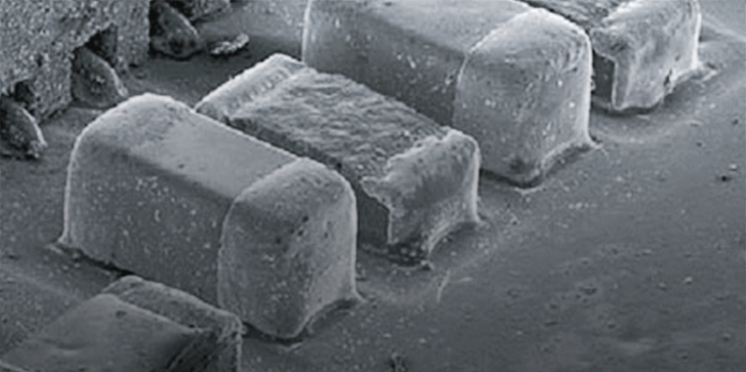Kikuchi pattern
Kikuchi pattern
The Kikuchi pattern is a diffraction pattern produced by Bragg reflections of inelastically scattered (thermal diffuse scattering) electrons in a specimen. Since the inelastically scattered electrons distribute over large angles, the Bragg reflections by the inelastically scattered electrons do not form diffraction spots but form a pair of excess and defect lines (Kikuchi lines) respectively by hkl and -h-k-l reflections. The low-intensity (defect) Kikuchi lines appear near side of the direction of the incident beam, whereas the high-intensity (excess) Kikuchi lines appear far side of the direction.
When low-order reflections hkl and -h-k-l are strongly excited, a high-intensity (excess) band (Kikuchi band) is formed between the reflections due to a strong dynamical diffraction effect. Kikuchi lines appear sharply for a highly perfect and thick crystal. Kikuchi patterns are effectively used for precise adjustment of a crystal orientation by tilting the crystal for the Kikuchi lines to locate on the Bragg reflection spots.

(a) Kikuch lines: When the electrons inelastically scattered at a certain point O in a crystal cause Bragg reflections from the front face (F) and the back face (B) of a crystal plane quite inclined against the direction of incident electrons I, a pair of defect intensity and excess intensity lines which are called Kikuchi lines (KL) are produced at the positions (directions) of the Bragg reflections 1 and 2. The intensity of Kikuchi line (1) near side of I is lower than that of the surrounding area (directions). To the contrary, the intensity of Kikuchi line (2) far side of I is higher than that of the surrounding area (directions).
The amplitude of the electrons inelastically scattered at the point O is large at low scattering angles and becomes small as the scattering angle increases. The Bragg reflection (2) from the front face (F) of a crystal plane due to the electrons inelastically scattered near the incident direction I forms strong excess and strong defect Kikuchi lines. The Bragg reflection (1) from the back face (B) of the crystal plane due to the inelastically scattered electrons far from the direction I compensates the contributions from the front face. However, since the compensation by the latter is small, the low intensity (defect) KL (1) is formed near side of I, and the high intensity (excess) KL (2) is formed far side of I.
(b) Transformation from Kikuch lines to Kikuchi band: When the inclined angle of the crystal plane becomes small with respect to the direction of the incident electrons I, the difference of the amplitudes of inelastically scattered electrons incident on the reflection planes F and B becomes small. As a result, the bell-shaped intensity of Kikuchi lines becomes low, the symmetrical feature is lost, but an asymmetric (dispersion type) intensity starts to appear.
(c) Kikuchi band: When the crystal plane becomes symmetric with respect to the direction of the incident electrons (I), the amplitudes of inelastically scattered electrons become equal for the Bragg reflections 1 and 2. As a result, the bell-shaped intensity vanishes and then, the dispersion type intensity is formed due to a strong dynamical diffraction effect. In the angular region between the positions (directions) 1 and 2, the intensity becomes higher than outside the region. This high intensity band is called Kikuchi band (KB).
(d) Kikuchi pattern obtained from a Si single crystal: Many pairs of Kikuchi lines due to high-order reflections are seen. In the vicinity of a symmetric incidence, a Kikuchi band is seen between “G = 220 reflection” and “G = -2-20 reflection”. The low-intensity (defect (dark)) Kikuchi lines appear near side of the incident beam direction, whereas the high-intensity (excess (bright)) Kikuchi lines appear far side of the direction. (However the Kikuchi pattern below is shown with reversal of bright and dark.)

When low-order reflections hkl and -h-k-l are strongly excited, a high-intensity (excess) band (Kikuchi band) is formed between the reflections due to a strong dynamical diffraction effect. Kikuchi lines appear sharply for a highly perfect and thick crystal. Kikuchi patterns are effectively used for precise adjustment of a crystal orientation by tilting the crystal for the Kikuchi lines to locate on the Bragg reflection spots.

(a) Kikuch lines: When the electrons inelastically scattered at a certain point O in a crystal cause Bragg reflections from the front face (F) and the back face (B) of a crystal plane quite inclined against the direction of incident electrons I, a pair of defect intensity and excess intensity lines which are called Kikuchi lines (KL) are produced at the positions (directions) of the Bragg reflections 1 and 2. The intensity of Kikuchi line (1) near side of I is lower than that of the surrounding area (directions). To the contrary, the intensity of Kikuchi line (2) far side of I is higher than that of the surrounding area (directions).
The amplitude of the electrons inelastically scattered at the point O is large at low scattering angles and becomes small as the scattering angle increases. The Bragg reflection (2) from the front face (F) of a crystal plane due to the electrons inelastically scattered near the incident direction I forms strong excess and strong defect Kikuchi lines. The Bragg reflection (1) from the back face (B) of the crystal plane due to the inelastically scattered electrons far from the direction I compensates the contributions from the front face. However, since the compensation by the latter is small, the low intensity (defect) KL (1) is formed near side of I, and the high intensity (excess) KL (2) is formed far side of I.
(b) Transformation from Kikuch lines to Kikuchi band: When the inclined angle of the crystal plane becomes small with respect to the direction of the incident electrons I, the difference of the amplitudes of inelastically scattered electrons incident on the reflection planes F and B becomes small. As a result, the bell-shaped intensity of Kikuchi lines becomes low, the symmetrical feature is lost, but an asymmetric (dispersion type) intensity starts to appear.
(c) Kikuchi band: When the crystal plane becomes symmetric with respect to the direction of the incident electrons (I), the amplitudes of inelastically scattered electrons become equal for the Bragg reflections 1 and 2. As a result, the bell-shaped intensity vanishes and then, the dispersion type intensity is formed due to a strong dynamical diffraction effect. In the angular region between the positions (directions) 1 and 2, the intensity becomes higher than outside the region. This high intensity band is called Kikuchi band (KB).
(d) Kikuchi pattern obtained from a Si single crystal: Many pairs of Kikuchi lines due to high-order reflections are seen. In the vicinity of a symmetric incidence, a Kikuchi band is seen between “G = 220 reflection” and “G = -2-20 reflection”. The low-intensity (defect (dark)) Kikuchi lines appear near side of the incident beam direction, whereas the high-intensity (excess (bright)) Kikuchi lines appear far side of the direction. (However the Kikuchi pattern below is shown with reversal of bright and dark.)

Related Term(s)
Term(s) with "Kikuchi pattern" in the description
Are you a medical professional or personnel engaged in medical care?
No
Please be reminded that these pages are not intended to provide the general public with information about the products.




